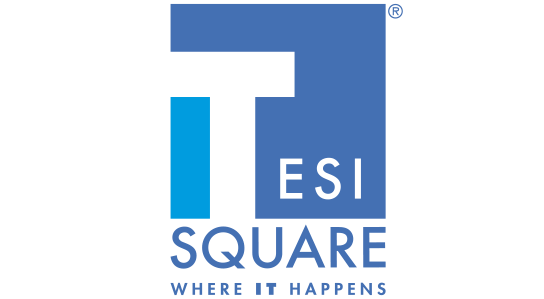The online e-cigarette market has expanded significantly in recent years, becoming one of the fastest growing sectors in the global landscape.
However, this rapid evolution is not without its challenges, especially in terms of compliance with constantly updated regulations. Indeed, the new regulations introduced on 1 January 2025 represent a turning point for eCommerce, which will have to adapt to stricter rules aimed at ensuring greater safety for consumers and preventing minors from accessing nicotine-containing products.
In this article, we will therefore explore the evolution of the global and Italian e-cigarette market; as well as the regulatory framework, with a detailed look at the new regulations that came into force on 1 January 2025 and the resulting implications for eCommerce.
The rapid expansion of the online e-cigarette market
Electronic cigarettes first appeared on the global market in the early 2000s, but it is only in the last decade that they have gained significant popularity. This trend is certainly driven by the growing awareness of the risks of traditional smoking and the subsequent demand for alternatives perceived as less harmful. While the tobacco industry initially viewed this new segment with suspicion, perceiving it as a potential threat, many companies soon realised its potential and therefore entered the e-cig market by developing their own products, such as non-combustible heating cigarettes (e.g. IQOS) and other nicotine devices.
Within a short period of time, e-cigarettes have thus found their way into the hands of smokers all over the world, to the extent that sales of traditional cigarettes have slowly declined in many countries, while those of e-cigs have grown exponentially, helping to redefine the entire sector.
The online e-cigarette market in the world
Statista forecasts that the global e-cigarette market will be worth $27.2 billion in 2025, with a compound annual growth rate (CAGR) of 3.73% between 2025 and 2029 . The US is the largest market, with estimated revenues of $9.4 billion, followed by Europe and Asia.
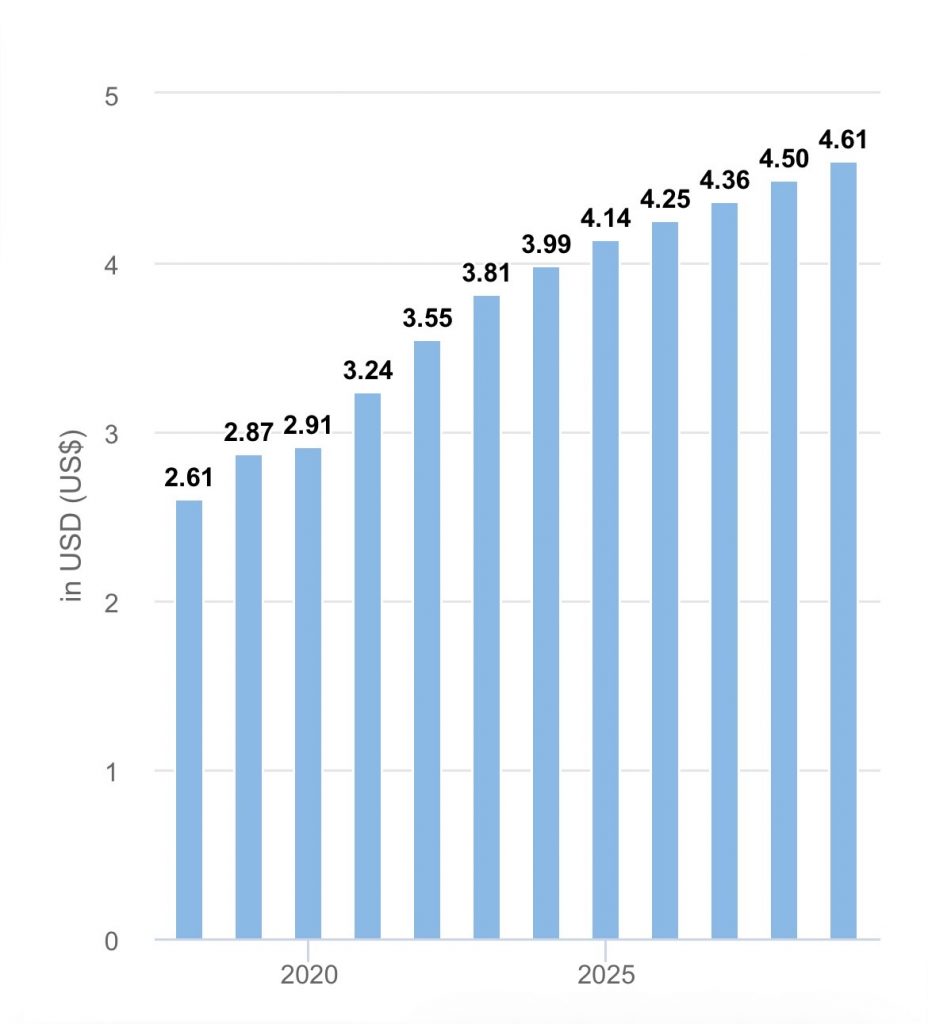
Fonte grafico: Statista
In 2025, online sales accounted for 16% of total sales, but the share of online will reach 20.9% by 2029 (in 2020 it was only 7.8%).
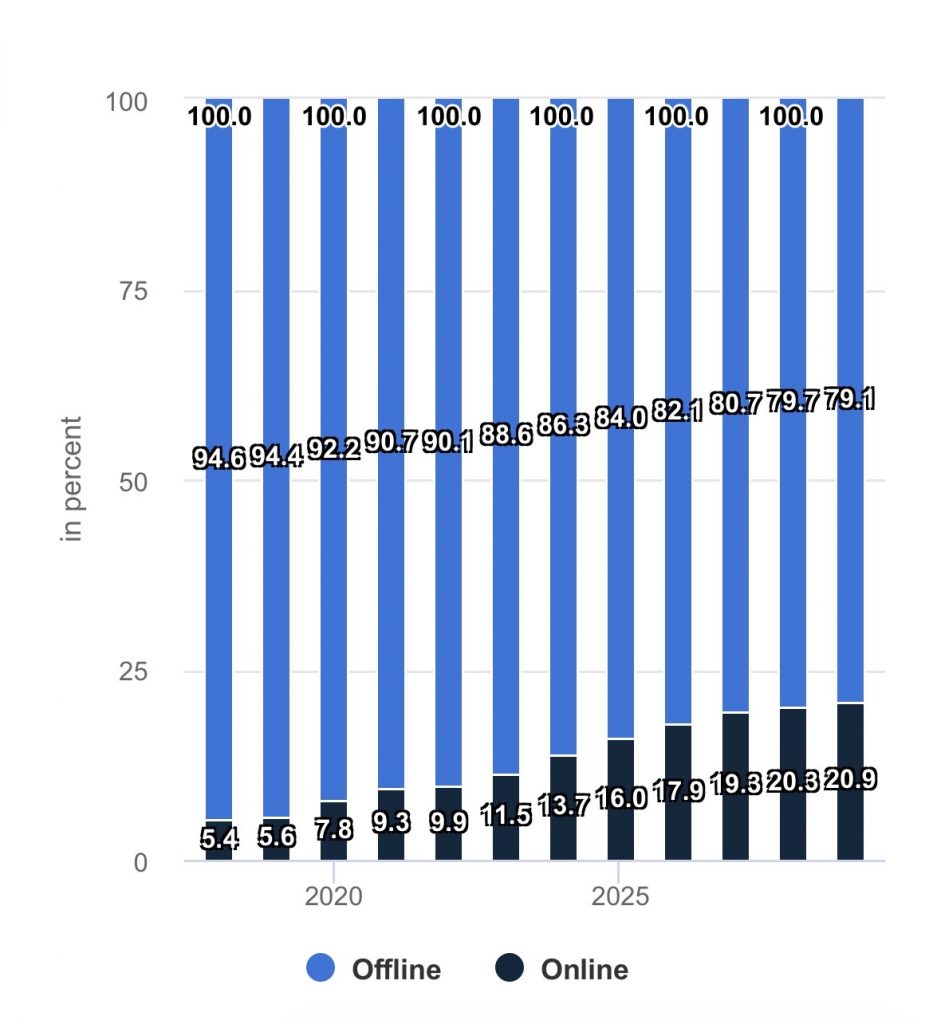
Fonte grafico: Statista
The online electronic cigarette market in Italy
In Italy, again according to Statista’s analysis, the e-cigarette market will generate revenues of $195.3 million by 2025, with an annual growth rate of 2.96% .
This expansion is fuelled by the growing demand for non-combustion products and the increasing focus on alternatives to traditional cigarettes, which are perceived as less harmful.
Who are the e-cigarette users in Italy
According to ISTAT data, in 2021, approximately 1.5 million Italians over the age of 14 regularly used e-cigarettes, i.e. 2.8% of the population .
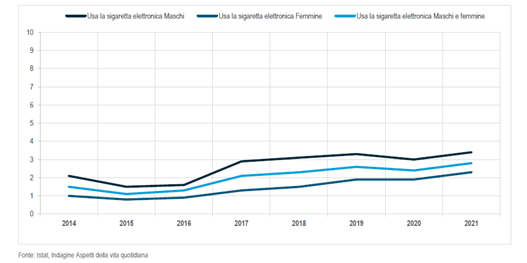
Fonte grafico: ISTAT
Consumption is most widespread among young people aged between 18 and 34, with a prevalence of 5.2% in this age group. Moreover, three quarters of e-cigarette users are also smokers of traditional tobacco, which means that these devices are often used in combination with – and therefore not as a substitute for – traditional smoking.
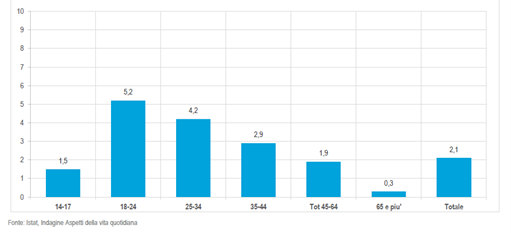
Fonte grafico: ISTAT
However, the online trade in e-cigarettes has raised important regulatory issues. Indeed, the online sale of e-cigarettes is subject to increasingly stringent regulations, especially to prevent access by minors and to regulate the distribution of nicotine-containing products.
Current legislation on the online sale of electronic cigarettes
The e-cigarette sector is regulated by a series of regulations to ensure consumer safety and to limit access to minors.
Until recently, the online sale of electronic cigarettes and related refill liquids was regulated by Legislative Decree No. 6 of 12 January 2016, which transposed Directive 2014/40/EU. Key provisions included:
- The sale of e-cigs limited to the national territory, thus prohibiting cross-border online sales and limiting eCommerce operations to the Italian territory;
- A ban on sales to minors, with an obligation for online retailers to implement effective systems to verify the age of buyers;
- The prohibition of any form of direct or indirect advertising of products, including digital channels such as websites and social media.
Online sale of electronic cigarettes: new rules as from 1 January 2025
As of 1 January 2025, however, Legislative Decree No. 141 of 26 September 2024 introduced important new restrictions, including:
- The ban on the online sale of nicotine-containing products, which may then only be sold in tobacconists or authorised sales outlets;
- Only nicotine-free products can be sold online, but only in compliance with the regulations laid down by the Customs and Monopolies Agency .
Implications for eCommerce selling electronic cigarettes
The question to be asked at this point is what, in practice, changes for eCommerce businesses operating in this sector? The answer is rather obvious: they will have to take measures to ensure their own compliance.
In practical terms, eCommerce should:
- Remove all banned products, i.e. those containing nicotine, from their online stores;
- Implement a rigorous quality control process to verify that all products sold online comply with new legislation;
- Communicating transparently with its customers, informing them of regulatory changes, and at the same time notifying suppliers and business partners of new operational guidelines, requesting exclusive supply of nicotine-free products and ensuring that they too comply with regulations.
Penalties for non-compliant eCommerce
Penalties for eCommerce businesses that do not comply with the new regulations range from EUR 30,000 to EUR 150,000 per violation established, depending on the seriousness and nature of the violation. In case of recidivism, penalties may double.
In addition, the Competition and Market Authority (AGCM) may impose further sanctions of up to EUR 10 million for unfair commercial practices, including misleading or non-compliant advertising.
Balancing innovation and regulation: the future of the online e-cigarette market
The online e-cigarette market is, as we have seen, a dynamic sector with great opportunities for growth. However, growing consumer demand and the expansion of digital commerce are balanced by increasingly stringent regulations, which present the sector with significant challenges.
For merchants in the sector, investing in transparency, quality control and efficient delivery methods such as Locker and Pick-up Points may be the key to maintaining competitiveness in a rapidly changing market. The future of the online e-cig market will therefore depend on the ability to balance innovation and regulatory compliance, creating an environment in which the needs of all, from consumers to institutions, can be effectively addressed.
If you have an online store for electronic cigarettes (nicotine-free!) and you want to offer your customers to pick up their online orders at over 300,000 already active Lockers and Pick-up Points, choose GEL Proximity!
You can connect GEL Proximity using our dedicated libraries and APIs or by downloading the module from the marketplace of your eCommerce software. Find out how to integrate now!











